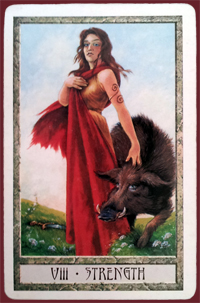
Spoiler Alert: In the following discussion with tarot reader Nan Budinger some key plot elements from the film “Beasts of the Southern Wild” are revealed. See the movie before reading further.
Thrum: Nan, you are a corporate namer – you’ve named companies and products. You’ve written screenplays. Spent lots of time thinking about images and stories. How did you become interested in tarot?
Nan: I was moving my office from one location to another and I came across the business card of a tarot reader I had met years before at a party. I thought, “This is a time of great transition!” I’d never had a tarot reading and I didn’t have a clue what they were about. I just knew that this reader was an interesting person, so I thought it might be fun to get a reading. The experience included a great moment of recognition. I realized that tarot was all about engaging archetypal imagery. It just made so much sense to me. I was delighted. I gathered as many books on tarot as I could, and read as much as I could. I learned that tarot is a mystery tradition and that I really needed a teacher. So I looked on line and discovered some tarot classes were starting the following week. I took classes for a year and about nine months into the process my teacher said, “You should be doing this too.”
T: Do you feel that there is a storytelling aspect to reading tarot?
N: Yes. The cards all contain images of deep symbolic and archetypal significance. So the way that you do a reading is that a question or a problem is posed and you put a spread of cards in a pattern. Then you look to find the story that is emerging through the relationships of the images offered by the cards in relationship to the question or the problem that has been posed. So, yes, it’s a lot of storytelling.
T: Do you see any similarity between film editing and what’s going on when you are doing a reading?
N: I’d say the primary difference is intent. With film editing, as I understand it, what you try to do is create associations that are relevant from one scene to the next. And that happens most often through the placement of images that have particular symbolic meaning. So the film editor is creating associations that may remain more-or-less unconscious to the viewer, but the viewer nonetheless experiences a sense of continuity in terms of the storytelling. With tarot, however, you’re working with a pattern of images that came into relationship with each other without your conscious intent. The film editor crafts associations, images and their relationships. But with tarot you’re looking at images as they are placed in relationship to each other within the spread – and interpreting them on behalf of the client. And, hopefully, you’re able to get your ego out of the way and let the imagery speak.
T: You recently saw the movie “Beasts of the Southern Wild.” How did you like it?
N: I thought it was really wonderful. It was a movie that seemed to trust in the images themselves to be able to carry the movie. There was little dialogue. The plot was really, really simple, following a young girl on an archetypal journey to establish herself in the world.
